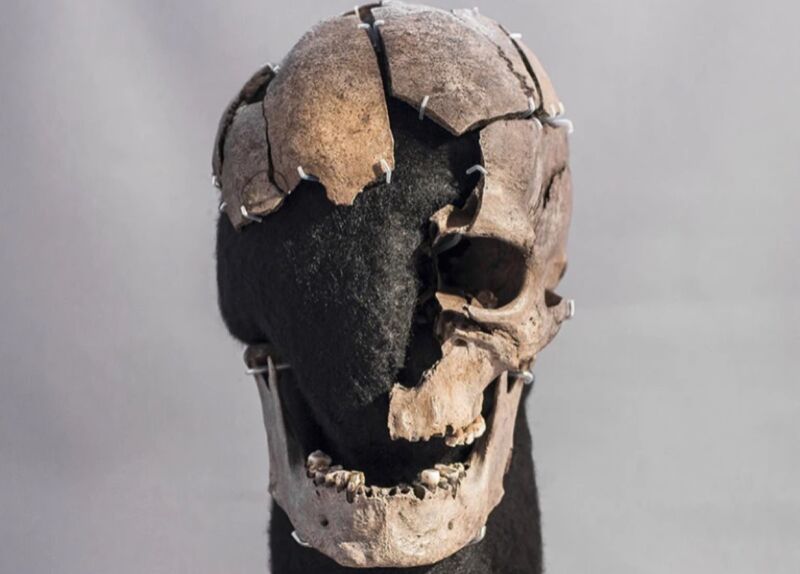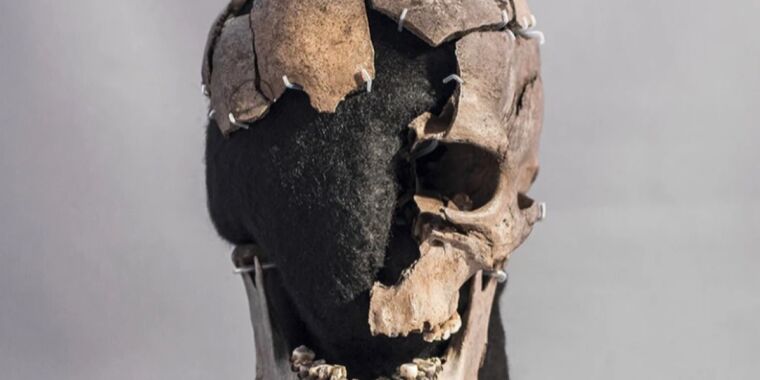Brutally bludgeoned “Vittrup Man” went from forager to farmer before his death
From forager to farmer —
The skull was shattered by at least eight blows before the body was tossed into a peat bog.

Enlarge / The cranial remains of Vittrup Man, who was bludgeoned to death and tossed in a peat bog between 3300-3100 BCE.
Stephen Freiheit via Fischer A., et al./PLoS ONE
In 1915, peat diggers recovered the fragmented skeletal remains of a man with a severely fractured skull in a peat bog near the village of Vittrup in Denmark. The remains were kept in a museum for the next century, but scientists have now conducted an in-depth analysis of the remains using various techniques to learn more about the so-called Vittrup Man’s life and violent death. They described their findings in a recent paper published in the journal PLoS ONE—including the surprising fact that Vittrup Man grew up in a coastal foraging community along the Scandinavian coast before his murder as an adult in a farming culture in Neolithic Denmark.
Vittrup Man is one of numerous “bog bodies” unearthed from peat bogs in northwestern Europe. These are human cadavers that have been naturally preserved and frequently mummified by the unique chemistry of the bogs. As peat ages, it releases humic acid, which has a pH level similar to vinegar. The bog bodies are basically pickled, and decomposition is dramatically slowed because of the anaerobic conditions of the bog. The best-preserved bog bodies are those that were put there during the winter or early spring when the water is very cold—less than 4° Celsius (39° F), i.e., too cold for bacteria to thrive—because the bog acids were able to saturate the tissues before decay could begin.
Peat has been a common fuel source since the Iron Age, and there are records of peat diggers coming across bog bodies dating back to 1640 in Germany. Bog bodies became of interest to antiquarians in the 19th century and archaeologists in the 20th century. One of the most famous examples is Tollund Man, a bog body found in the 1950s and dating back to the 5th century BCE. Tollund Man was so exquisitely mummified that he was originally mistaken for a recent murder victim, although only the head was preserved for posterity; the rest of the body was allowed to desiccate, given the less advanced state of preservation techniques in the 1950s.
But many bog bodies are only partially preserved, or only the skeletons (or parts thereof) survive. Vittrup Man falls into the latter category, consisting of a right ankle bone, the left tibia, the fractured skull, and a jawbone. He was discovered along with a wooden club, which archaeologists believe may have been the weapon used to bludgeon him to death. Various radiocarbon dating and isotope analyses confirmed that the bones all belonged to the same individual, while genetic analysis confirmed the remains were those of a male. He was likely deposited in the peat bog sometime between 3300–3100 BCE.
-
Left lower leg bone and right ankle bone of Vittrup Man.
Marie Louise Jorkov/Fischer A., et al./PLoS ONE
-
The jawbone of Vittrup Man showing several worn teeth.
Arnold Mikkelsen/Fischer A., et al./PLoS ONE
-
Drawing of Vittrup Man’s cranium showing front and back views of impact lesions and radiating fracture lines.
Fischer A., et al./PLoS ONE
-
Drawing of Vittrup Man’s cranium showing right and left side views of impact lesions and radiating fracture lines.
Fischer A., et al./PLoS ONE
Vittrup Man was included in a sweeping 2014 genomic project to learn more about Eurasia’s Mesolithic and Neolithic gene pools, but the resulting genetic profile was markedly different from other remains from the same region and time period. This intrigued University of Gothenburg (Sweden) archaeologist Karl-Göran Sjögren and his co-authors, and they decided to take a closer look, integrating data collected with various genetic, isotopic, physical, anthropological, and archaeological techniques. “To our knowledge, this is the first time that research has been able to map a north European inhabitant’s life history in such a high degree of detail and in such a high distance of time,” the authors wrote.
The size and distinctive characteristics of the skull, lower leg bones, and teeth indicate that at the time of his death, Vittrup Man was an adult male in his 30s. The cranium was shattered by at least eight blows delivered by a blunt object (like the wooden club), and the injuries were fatal, with no signs of healing post-trauma. There are no marks on the surviving bones indicating dismemberment, so the authors believe the body may have come apart while decomposing in the bog. It’s possible more Vittrup Man fragments have yet to be recovered.
But the clues gleaned from two of Vittrup Man’s teeth (sacrificed to science) are what provided the most interesting insights. Sjögren et al. found isotopes of strontium, carbon, and oxygen and concluded that the man had grown up along the coast of the Scandinavian Peninsula. Genetic analysis showed commonalities with Mesolithic people of Norway and Sweden; Vittrup Man had blue eyes and darker skin than the usual Neolithic farmer. The teeth and bones also had proteins and isotopes indicating a shift in diet from marine mammals and fish as a child, to sheep, goat, cereals, and dairy as an adult—the latter more typical of a farming community as opposed to a coastal foraging community.
Why Vittrup Man left the Scandinavian coast and ended up in Denmark remains a mystery. He may have been captured and enslaved or immigrated, or he may have been a foreign merchant selling goods like flint axes between foraging and farming communities. Either way, he eventually integrated into the farming community—at least until they killed him.
As for why he was killed, “At that time, it was commonplace in present-day Denmark to sacrifice humans in bogs, and these acts were often conducted in violent ways,” the authors concluded. “Evidently, such dubious honor was also given to persons of nonlocal provenance.”
PLoS ONE, 2024. DOI: 10.1371/journal.pone.0297032 (About DOIs).
Brutally bludgeoned “Vittrup Man” went from forager to farmer before his death Read More »
